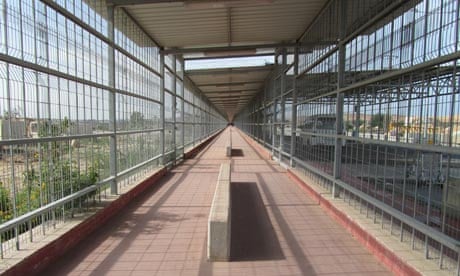In Siegebreakers, all of the main characters face a serious, and very concrete, problem: getting in and out of Gaza.
Some are trying to get out, and to do that, they have to go through Israel – through Erez Crossing, which is a scene out of a dystopian future. A few years ago I interviewed a doctor who had made the crossing. He talked a bit about what it was like coming and going from Israel, but I also put a description together (for the book) from that and a few other interviews of what it is like to go through Erez (I went through Erez myself in 2002, but that was before it was rebuilt into its current form):
Laila made the long walk through the wire-encaged sidewalk, like an enclosure at a zoo, to the first turnstile. Israel modified these turnstiles to reduce the space between the arms, to press harder against Palestinian bodies. Remote-controlled, of course, by the occupier’s security who watched her progress through the tunnel from above. Through the turnstile — if the invisible occupier chose to open it, by remote control — then, a big steel door. Also, remote-controlled. Once it opened, there was another long, outdoor passageway to the terminal. She rolled her bag along behind her, her shoulders slouching when she forgot herself, but when she remembered, with her back arched and her chin up. She faced the sliding steel doors at the entrance to the terminal, waited in suspense for the occupier’s decision to open or close it. They opened it for her, so she could go through the metal detector and the next set of turnstiles. She put her luggage on the carousel and it disappeared into another room, where someone working for the occupier went through her every possession. Then, the occupier used a scanner to create a three-dimensional model of every centimetre of her body… More remote-controlled doors. More modified metal turnstiles. Laila claimed her bag and went to face the occupier’s passport inspectors, who sat in blast-proof booths. She handed the inspector her documents...
I won’t spoil what happens next, but let’s continue on the problem of getting in and out of Gaza. Anyone trying to get goods in or out of Gaza has to use a different high-tech remote-controlled crossing, Kerem Abu Salem. The description of how that crossing works is assembled from the organization Gisha.org. Play a round of Safe Passage, if you’re up for the frustration.
And then there’s Rafah, the crossing to and from Egypt. Taking a look at Rafah is where you see how much a participant Egypt’s dictatorship is in the siege of Gaza.
Sea and air? Not happening. I wouldn’t even have my fictional characters try. Some years ago I was asked why people don’t just fly into Gaza through Yasser Arafat International Airport. Grand opening: November 1998. Grand closing (via Israeli bombs): October 2000.
The Great March of Return, which has shaped Gaza’s politics for over a year now and which is one event I didn’t anticipate in Siegebreakers, is about all of the rights that are denied to Palestinians, but it is deeply about the fundamental right to come and go, the right to not be born and live one’s whole life in a prison, which is Israel’s (and Egypt’s, and the US, and Canada, and all of the allies collaborating in the siege) design for every single person in Gaza (children included). Abby Martin’s new film, Gaza Fights for Freedom, filmed in large part by Palestinian journalists from Gaza, can show you what it looks like.
Those people marching to the fence every week? They’re the real-life Siegebreakers.

